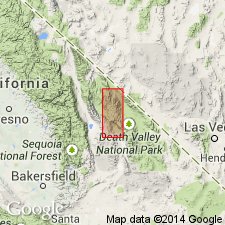
- Usage in publication:
-
- Leaning Rock Formation*
- Modifications:
-
- Original reference
- Biostratigraphic dating
- Dominant lithology:
-
- Limestone
- Chert
- Mudstone
- Shale
- AAPG geologic province:
-
- Great Basin province
Summary:
Pg. J5 (fig. 3), J7-J8 (fig. 4), J11-J13, J37. Leaning Rock Formation of Perdido Group. Rocks previously assigned to Perdido Formation (McAllister, 1952). Consists of interbedded, commonly deformed, dark-gray, cherty micrite, chert, mudstone, and shale. Thickness 83 m. Underlies Mexican Spring Formation (new) of Perdido Group; contact placed at base of lowest siltstone or sandstone. Overlies Tin Mountain Limestone. Is basal formation of Perdido Group. Age is late Early Mississippian (Osagean; Lower TYPICUS to MEHLI-Lower TEXANUS conodont zone of Poole and Sandberg, 1991; Mamet foraminiferal zones 7-12).
Type section: near Rest Spring in Cottonwood Mountains, about 4 km east of mouth of Perdido Canyon, between 6,160 and 6,240 ft elevation, in northwest corner of sec. 31, T. 13 S., R. 42 E., Lat. 36 deg. 45 min. 30 sec. N., Long. 117 deg. 26 min. 27 sec. W., White Top Mountain 7.5-min quadrangle, Inyo Co., Death Valley National Monument, eastern CA. Named from Leaning Rock Peak about 3 km southeast of type section.
Source: Publication.
For more information, please contact Nancy Stamm, Geologic Names Committee Secretary.
Asterisk (*) indicates published by U.S. Geological Survey authors.
"No current usage" (†) implies that a name has been abandoned or has fallen into disuse. Former usage and, if known, replacement name given in parentheses ( ).
Slash (/) indicates name conflicts with nomenclatural guidelines (CSN, 1933; ACSN, 1961, 1970; NACSN, 1983, 2005, 2021). May be explained within brackets ([ ]).

